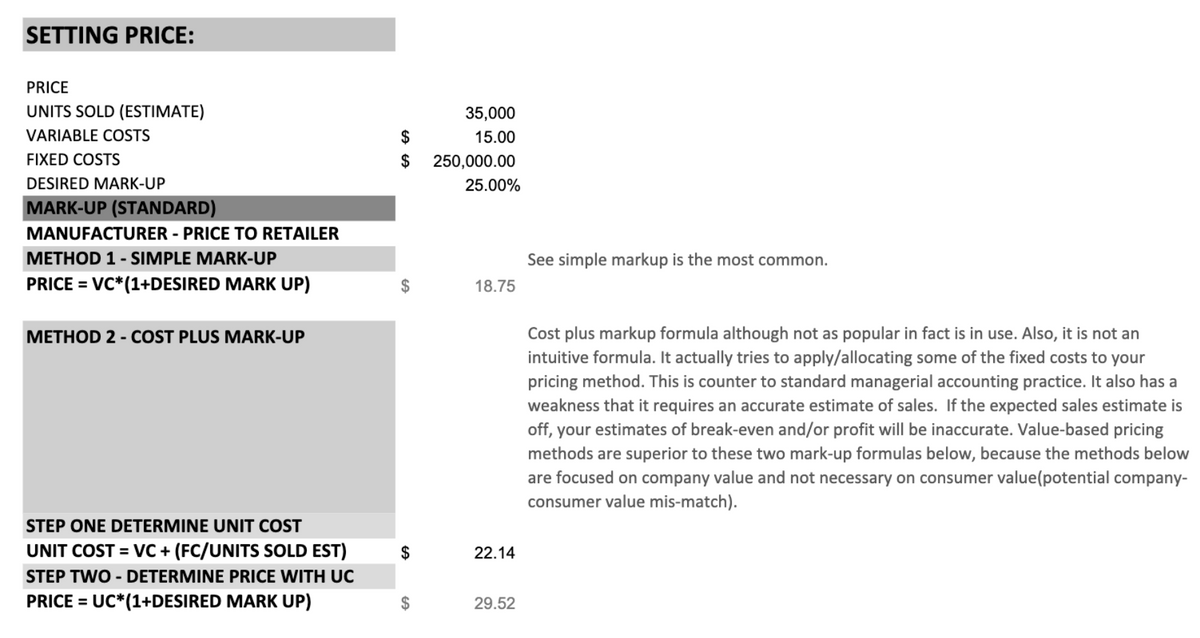What is false about cost plus mark-up pricing? a. attempts to apply or allocate fix costs to pricing strategy b. not intuitive c. good example of value-based pricing d. vulnerable to bad sales estimates e. All are correct f. All are incorrect
What is false about cost plus mark-up pricing? a. attempts to apply or allocate fix costs to pricing strategy b. not intuitive c. good example of value-based pricing d. vulnerable to bad sales estimates e. All are correct f. All are incorrect
Managerial Accounting
15th Edition
ISBN:9781337912020
Author:Carl Warren, Ph.d. Cma William B. Tayler
Publisher:Carl Warren, Ph.d. Cma William B. Tayler
Chapter11: Differential Analysis And Product Pricing
Section: Chapter Questions
Problem 19E
Related questions
Question
100%
What is false about cost plus mark-up pricing?
a. attempts to apply or allocate fix costs to pricing strategy
b. not intuitive
c. good example of value-based pricing
d. vulnerable to bad sales estimates
e. All are correct
f. All are incorrect

Transcribed Image Text:SETTING PRICE:
PRICE
UNITS SOLD (ESTIMATE)
35,000
VARIABLE COSTS
$
15.00
FIXED COSTS
$
250,000.00
DESIRED MARK-UP
25.00%
MARK-UP (STANDARD)
MANUFACTURER - PRICE TO RETAILER
METHOD 1 - SIMPLE MARK-UP
See simple markup is the most common.
PRICE = VC*(1+DESIRED MARK UP)
2$
18.75
%3D
Cost plus markup formula although not as popular in fact is in use. Also, it is not an
intuitive formula. It actually tries to apply/allocating some of the fixed costs to your
pricing method. This is counter to standard managerial accounting practice. It also has a
weakness that it requires an accurate estimate of sales. If the expected sales estimate is
off, your estimates of break-even and/or profit will be inaccurate. Value-based pricing
methods are superior to these two mark-up formulas below, because the methods below
are focused on company value and not necessary on consumer value(potential company-
METHOD 2 - COST PLUS MARK-UP
consumer value mis-match).
STEP ONE DETERMINE UNIT COST
UNIT COST = VC + (FC/UNITS SOLD EST)
$
22.14
STEP TWO - DETERMINE PRICE WITH UC
PRICE = UC*(1+DESIRED MARK UP)
2$
29.52
%3D
Expert Solution
This question has been solved!
Explore an expertly crafted, step-by-step solution for a thorough understanding of key concepts.
This is a popular solution!
Trending now
This is a popular solution!
Step by step
Solved in 2 steps

Recommended textbooks for you

Managerial Accounting
Accounting
ISBN:
9781337912020
Author:
Carl Warren, Ph.d. Cma William B. Tayler
Publisher:
South-Western College Pub

Survey of Accounting (Accounting I)
Accounting
ISBN:
9781305961883
Author:
Carl Warren
Publisher:
Cengage Learning

Managerial Accounting
Accounting
ISBN:
9781337912020
Author:
Carl Warren, Ph.d. Cma William B. Tayler
Publisher:
South-Western College Pub

Survey of Accounting (Accounting I)
Accounting
ISBN:
9781305961883
Author:
Carl Warren
Publisher:
Cengage Learning